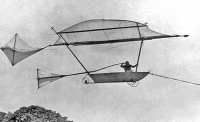








A glider is a heavier-than-air aircraft that is supported in flight by the dynamic reaction of the air against its lifting surfaces, and whose free flight does not depend on an engine.Most gliders do not have an engine, although motor-gliders have small engines for extending their flight when necessary and some are even powerful enough to take off.
There is a wide variety of types differing in the construction of their wings, aerodynamic efficiency, location of the pilot, controls and intended purpose. Most exploit meteorological phenomena to maintain or even gain height. Gliders are principally used for the air sports of gliding, hang gliding and paragliding. However some spacecraft have been designed to descend as gliders and in the past military gliders have been used in warfare. Perhaps the simplest and most familiar types are toys such as the paper plane and balsa wood glider.
Etymology
Glider is the noun form of the verb to glide. It derives from Middle English gliden, which in turn derived from Old English gl?dan. The oldest meaning of glide may have denoted a precipitous running or jumping, as opposed to a smooth motion. Scholars are uncertain as to its original derivation, with possible connections to "slide", and "light" having been advanced.
History of gliders
Early pre-modern accounts of flight are in most cases difficult to verify and it is unclear whether each craft was a glider, kite or parachute and to what degree they were truly controllable. Often the event is only recorded a long time after it allegedly took place. A 17th-century account reports an attempt at flight by the 9th-century poet Abbas Ibn Firnas near Cordoba, Spain which ended in heavy back injuries.The monk Eilmer of Malmesbury is reported by William of Malmesbury (c. 1080–1143), a fellow monk and historian, to have flown off the roof of his Abbey in Malmesbury, England, sometime between 1000 and 1010 AD, gliding about 200 metres (220 yd) before crashing and breaking his legs.According to these reports, both used a set of (feathery) wings, and both blamed their crash on the lack of a tail.
19th century
The first heavier-than-air (i.e. non-balloon) man-carrying aircraft that were based on published scientific principles were Sir George Cayley's series of gliders which achieved brief wing-borne hops from around 1849. Thereafter gliders were built by pioneers such as Jean Marie Le Bris, John J. Montgomery, Otto Lilienthal, Percy Pilcher, Octave Chanute and Augustus Moore Herring to develop aviation. Lilienthal was the first to make repeated successful flights (eventually totaling over 2,000) and was the first to use rising air to prolong his flight. Using a Montgomery tandem-wing glider, Daniel Maloney was the first to demonstrate high-altitude controlled flight using a balloon-launched glider launched from 4,000 feet in 1905.
The Wright Brothers developed a series of three manned gliders after preliminary tests with a kite as they worked towards achieving powered flight. They returned to glider testing in 1911 by removing the motor from one of their later designs.
Development of gliders
After World War I recreational gliders were built in Germany and in the United States (Schweizer brothers). The sporting use of gliders rapidly evolved in the 1930s and is now the main application. As their performance improved gliders began to be used to fly cross-country and now regularly fly hundreds or even thousands of kilometers in a day, if the weather is suitable.
Military gliders were developed during World War II by a number of countries for landing troops. A glider – the Colditz Cock – was even built secretly by POWs as a potential escape method at Oflag IV-C near the end of the war in 1944.
Development of flexible-wing hang gliders
Foot-launched aircraft had been flown by Lilienthal and at the meetings at Wasserkuppe in the 1920s. However the innovation that led to modern hang gliders was in 1951 when Francis Rogallo and Gertrude Rogallo applied for a patent for a fully flexible wing with a stiffening structure. The American space agency NASA began testing in various flexible and semi-rigid configurations of this Rogallo wing in 1957 in order to use it as a recovery system for the Gemini space capsules. Charles Richards and Paul Bikle developed the concept producing a wing that was simple to build which was capable of slow flight and as gentle landing. Between 1960–1962 Barry Hill Palmer used this concept to make foot-launched hang gliders, followed in 1963 by Mike Burns who built a kite-hang glider called Skiplane. In 1963, John W. Dickenson began commercial production.
Development of paragliders
January 10, 1963 American Domina Jalbert filed a patent US Patent 3131894 on the Parafoil which had sectioned cells in an aerofoil shape; an open leading edge and a closed trailing edge, inflated by passage through the air – the ram-air design.The 'Sail Wing' was developed further for recovery of NASA space capsules by David Barish. Testing was done by using ridge lift.After tests on Hunter Mountain, New York in September 1965, he went on to promote ‘slope soaring’ as a summer activity for ski resorts (apparently without great success).NASA originated the term ‘paraglider’ in the early 1960s, and ‘paragliding’ was first used in the early 1970s to describe foot-launching of gliding parachutes. Although their use is mainly recreational, unmanned paragliders have also been built for military applications e.g. Atair Insect.